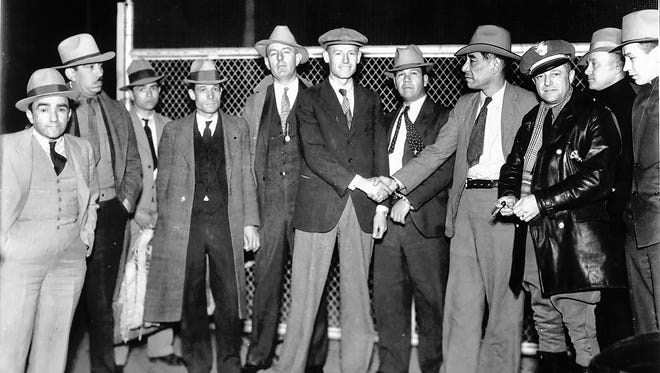[ad_1]
On April 15, 1834, a wagon train of 239 colonists left Mexico City for California. The expedition, under the command of Jose Maria Hijar and Col. Jose Maria Padres, was made up of 105 men, 55 women, and 79 children under 14. It included 22 teachers, 19 farmhands, 8 tailors, 8 carpenters, 12 seamstresses, 2 doctors, a candymaker, and a musician, among many other professions. The colonists’ average age was 20. The men in the party rode on horseback and were armed with rifles and swords. The wagons carried women, children and provisions, along with 10 Merino sheep and five Tibetan goats. The expedition was Mexico’s most ambitious attempt to colonize its distant province of California.
“It was a gala day, one that would have filled the long line of Spanish viceroys and Spanish and Mexican governors who had labored to colonize California with joy,” writes C. Alan Hutchinson in “Frontier Settlement in Mexican California: The Hijar-Padres Colony and its Origins, 1769-1835.” A government newspaper, El Telegrafo, treated the expedition as an epic event. “(T)he streets through which they passed were thronged with people filled with admiration and enthusiasm for the settlers, who had overcome the disinclination of their upbringing and the laziness left us by the Spanish, and had decided to leave behind the comforts of the capital and set out to guard the remotest regions of the Republic, [and found] new towns which are perhaps destined one day to change the face of this continent and direct the attention of the civilized world to places now entirely unknown.”
The Hijar-Padres party, as it known, did indeed help to found new towns, including San Francisco and Los Angeles. But it turned out to be a complete fiasco—one of the most egregious of the many missteps that marked Mexico’s feeble 25-year rule over California.
The expedition was the brainchild of Mexico’s liberal co-president, Valentin Gomez Farias. Farias intended it to accomplish two goals. First, it was to prevent the Russians, who had established an outpost at Fort Ross, from seizing Mexican territory. Second, it was to provide a humanitarian solution to the most pressing, and intractable, problem faced in California both by Mexico and by its former colonial master, Spain: What to do with the Indians. This issue was inextricably bound up with another urgent concern: The disposition of the millions of acres of land controlled by the missions.
It was a bitter dispute over these last two related issues, which pitted the governor of California and the settlers already living there against the new colony, that caused the Hijar-Padres party to fail.
The last question: After watching the 1930 Big Game between Cal and Stanford, who told a reporter, “Your game of football is splendid, thrilling, beautiful…a great living picture, spontaneous unconscious art”?
Answer: Diego Rivera.
This week’s question: What was “Fort Gunnybags”?
To understand this controversy, some background is necessary. The Spanish colonial project in California, whose heart was its network of missions extending from San Diego to Sonoma, was intended to turn the native people into “civilized” Christians, or “gente de razon” (“people of reason”) thereby saving their souls while making them into productive Spanish citizens. The best land in California was controlled by the missions, which theoretically held it in trust for the Indians, who were supposed to inherit the land when they became gente de razon.
This project had completely failed. Many of the Indians who had come into the missions died of disease or misery or ran away, and those that remained showed no interest in becoming farmers or working at other jobs. Even when given their own land, they had no interest in working it. They wanted to return to the free way they had lived before the Spanish came. After Mexico became independent from Spain in 1821, their lot did not improve, and in some ways became worse. Those who remained on the declining and demoralized missions, or who worked for the Mexican Californians (who had begun calling themselves Californios), were in effect serfs, whose unpaid labor allowed the wealthiest Californios, the rancheros, to enjoy a seigneurial lifestyle. Some lower-class Californios abused the Indians, giving them liquor and taking their clothes and their food.
Even before Mexico gained its independence, increasing numbers of liberal, progressive thinkers in Madrid and Mexico City had become critical of the church’s paternalistic approach to the Indians. Inspired by idealistic Enlightenment ideas and increasingly anti-clerical, they eventually demanded that the California mission system be ended. This demand was enshrined into law on August 17, 1833, when Mexico passed a law secularizing the California missions.
Most policymakers in Mexico and its distant California province supported the secularization of the missions. (The mission fathers, who naturally opposed it, were viewed with suspicion by Mexican officials.) But there was no consensus about what to do with the Indians, either those who were still living at the missions and those who were not.
The Mexican governor of California, Jose Figueroa, and the Californios took a paternalistic view of the California Indians, one similar to that held by the mission fathers. They believed the Indians were childlike creatures who could not simply be set free or treated as equals, because they would return to their old way of life. If they were given the mission lands, the missions—the engine of California’s economy—would be ruined, and unscrupulous Californios would swindle them out of the lands anyway. The Californios had arrived at these conclusions after decades of interactions with the Indians, and were convinced they spoke from experience. The most humane way to deal with the Indians, they argued, was to emancipate them very slowly and cautiously, if at all.
Farias and other Mexican liberals took a much more optimistic view. They regarded the Indians as fellow Mexicans and human beings, who would blossom into productive citizens if given education, encouragement, and land. Jose Maria Hijar’s views were typical. Hutchinson writes, “Hijar’s attitude toward the Indians was that reflected in the laws of the new Republic of Mexico—egalitarian as well as humanitarian. Although he found the mission Indians ‘degraded and demoralized to the extent that they will prostitute their daughters and wives,’ he considered that they and the pagan Indians in the interior had ‘wonderful natural talent.’ Comparing them favorably to Indians on the Mexican mainland, he said it could be inferred “that they possess elements which would help them towards civilization, in which they would make great progress with a policy different from the one used up until now by the three dominating classes (missionaries, soldiers, and settlers) whom they hate.’”
Both sides sincerely believed they had the Indians’ best interests at heart. But the Californios were also driven by self-interest: They wanted to get their hands on the mission lands.
A clash between the Californios and the new colonists was likely in any case. And when the Californios became convinced that the colonists were going to take the mission lands for themselves, that clash became inevitable. The story of the bitter feud between Figueroa and the leaders of the colony, and the ignominious collapse of entire venture, will be the subject of the next Portals.
Gary Kamiya is the author of the best-selling book “Cool Gray City of Love: 49 Views of San Francisco.” His most recent book is “Spirits of San Francisco: Voyages Through the Unknown City.” All the material in Portals of the Past is original for The San Francisco Chronicle. To read earlier Portals of the Past, go to sfchronicle.com/portals.
[ad_2]
Source link















